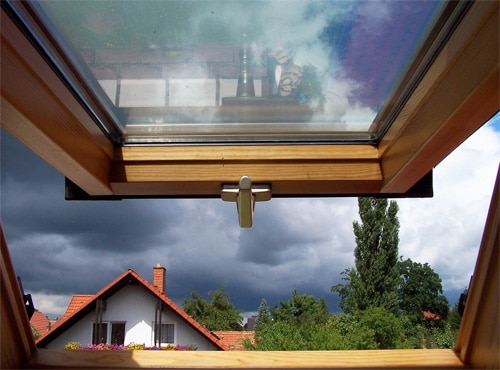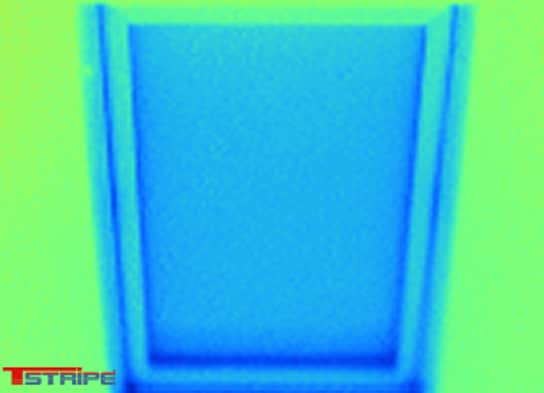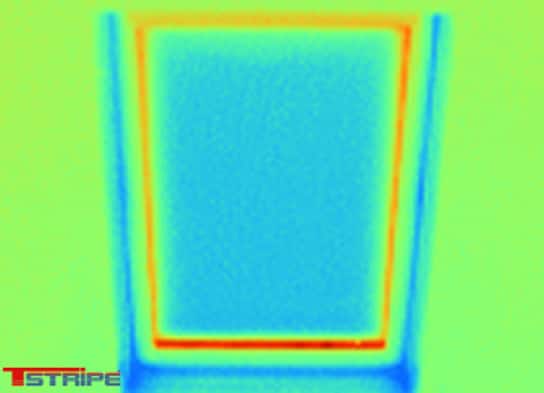Condensation depends on various factors, most importantly humidity and surface temperature.
 To prevent condensation water regular ventilation constitutes a first step (40%-60% would be best), but to avoid any condensation from forming rising the surface temperature of your windows is absolutely vital. This is where T-STRIPE fills the gap.
To prevent condensation water regular ventilation constitutes a first step (40%-60% would be best), but to avoid any condensation from forming rising the surface temperature of your windows is absolutely vital. This is where T-STRIPE fills the gap.
- Measure temperature and humidity in your room.
- Calculate the dew point in your room.
- Raise your living comfort considerably!
By simply measuring the air temperature, humidity and surface temperature of your walls you can already determine damaging residual water in your walls and window constructions.
Knowledge of these interrelationships in terms of room climate will help you make the right decisions when it comes to improving living comfort in your own home. Gathering this data will also help you understand how T-STRIPE works; heating up important areas of your windows and changing the dew point!
| Room temperature in °C | Amount of water (g/m3) in the air* |
| ± 0 | 4.8 |
| + 2 | 5.6 |
| + 4 | 6.4 |
| + 6 | 7.3 |
| + 8 | 8.3 |
| + 10 | 9.4 |
| + 12 | 10.7 |
| + 14 | 12.1 |
| + 16 | 13.7 |
| + 18 | 15.4 |
| + 20 | 17.3 |
| + 22 | 19.5 |
| + 24 | 21.8 |
| + 26 | 24.4 |
| + 28 | 27.2 |
| + 30 | 30.4 |
* at 100% humidity
How exactly does condensation water occur on window panes?
Especially outer walls and roof pitches suffer from condensation a lot. On the inside of these locations, the necessary circulation of air is oftentimes being hindered by suboptimal positioning of radiators, curtains and window sills. As soon as warm air cannot reach all these areas condensation can cause serious damage within walls and windows and even cause mold and mold spores to plague residents.
Air will always contain invisible water vapors. The warmer the air the better those vapors are being bound within. The colder the air, the worse its ability to bind them.
The temperature at which air humidity hits 100% is commonly being called dew point temperature. Cooling air down will result in a dissipation of water vapors which will condense on surfaces like window panes.
Another reason for condensation water is the accumulation of humidity in the air.
Cooking fumes and steam from a bath are possible sources of additional humidity, as are plants and humans. In a cold bedroom simply sleeping and therefore breathing regularly can cause condensation to occur. Bad airing and circulation only add to these phenomena.
In every household there are warmer and colder areas, which are being influenced by a variety of factors:
- setup of windows and radiators
- the ability of heated air to circulate
- building and window insulation
Relative humidity always depends on room temperature. As soon as humidity hits 100% condensation will occur. For example, when air at 20°C and 50% humidity hits a surface below 10°C condensations will occur. See our infographic for further information.
Tests have shown that the surface temperature of a typical window pane can drop down to a mere 6°C along the edges of the window, while the center of the glass pane can still be at 19°C. That is the main reason for condensation water to form along the edges of the window.

Without T-STRIPE Condensation depends on various factors, most importantly humidity and surface temperature.

With T-STRIPE
Why does this happen?
The frame construction of a window usually has a worse heat transfer coefficient than the pane itself. Additionally, as soon as there is an additional pane in the construction (double or triple-pane insulation windows) the outer pane usually cools down to outside temperature rather quickly, draining the inner pane of heat. No matter what the heat transfer coefficient of the window pane might be (in most cases around 1.1), due to this happening the window pane will cool down as well, especially if there is no radiator beneath the window, or when a curtain or broad sill constricts airflow. And wherever circulation is being restricted, the window will cool down and condensation will occur.
Skylights
Skylights usually are exposed more to weather conditions such as snow, rain, or hail than normal windows. Raising the surface temperature of these window panes is absolutely vital in preventing condensation. If you have no radiators below your windows, then T-STRIPE can help you!
Do you have condensation water on window panes?
T-STRIPE is the solution for all our condensation and mold problems. Dry window panes and frames with a high-quality window heating system.





